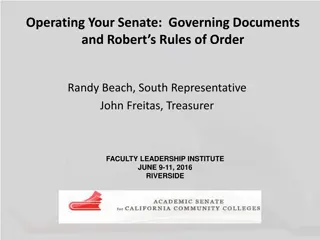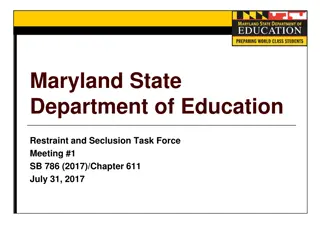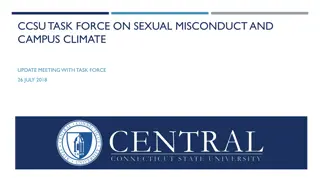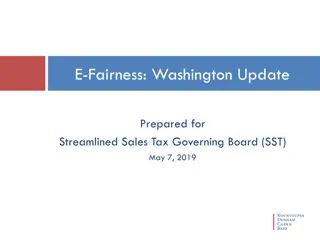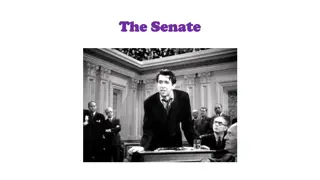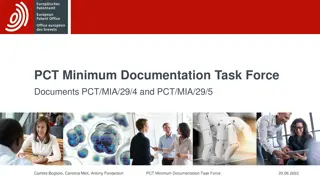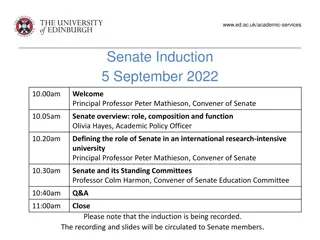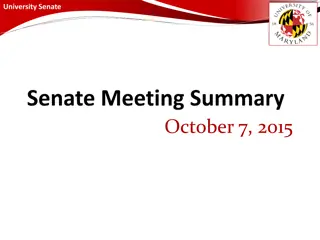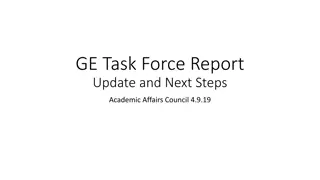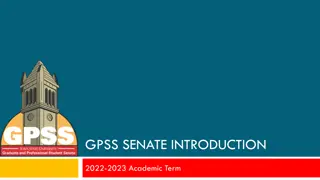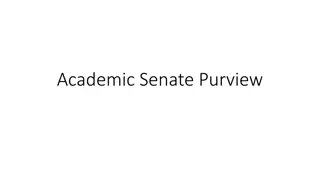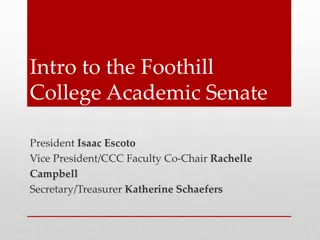Senate Revision Task Force Update Analysis
A detailed analysis of three scenarios proposed for the Senate revision task force update presented on May 4, 2017. Each scenario outlines the potential models with their positives and drawbacks, considering voting members, division representation, and voting formulas. The discussion encompasses the current model, a possible Senate model, and a possible Congress model, highlighting the impact on division representation, voting dynamics, and potential challenges. Various voting structures, member allocations, and implications for division equality and participation are explored in the assessment.
Download Presentation

Please find below an Image/Link to download the presentation.
The content on the website is provided AS IS for your information and personal use only. It may not be sold, licensed, or shared on other websites without obtaining consent from the author.If you encounter any issues during the download, it is possible that the publisher has removed the file from their server.
You are allowed to download the files provided on this website for personal or commercial use, subject to the condition that they are used lawfully. All files are the property of their respective owners.
The content on the website is provided AS IS for your information and personal use only. It may not be sold, licensed, or shared on other websites without obtaining consent from the author.
E N D
Presentation Transcript
Representative Senate Revision Task Force Update Presented on May 4, 2017
Scenario 1: The Current AS Model Total voting members: 15 Total members: 17 - 22 Quorum: 8 President Past President Vice President 1 vote Secretary 1 vote Treasurer 1 vote ASLT 1 vote (1 rep) BEPP 1 vote (1-2 reps) Counseling 1 vote (1-2 reps) GLPS 1 vote (1 rep) KAD 1 vote (1 rep) LA 1 vote (2 reps) SMT 1 vote (2 reps) SS/CA 1 vote (2 reps) Curriculum 1 vote Ed Policy 1 vote Prof. Personnel 1 vote CTE Liaison 1 vote Positives: Divisions have regular representation in attendance. All divisions have an equal vote (1). Drawbacks: Not every division rep present can vote. Liaison has overlapping representation.
Scenario 2: Possible Senate Model President Past President Vice President 1 vote Secretary 1 vote Treasurer 1 vote ASLT 2 vote (2 reps) BEPP 2 vote (2 reps) Counseling 2 vote (2 reps) GLPS 2 vote (2 rep) KAD 2 vote (2 rep) LA 2 vote (2 reps) SMT 2 vote (2 reps) SS/CA 2 vote (2 reps) Curriculum 1 vote Ed Policy 1 vote Prof. Personnel 1 vote At-Large Part-time 2 votes (2 reps) Liaisons (CTE, SEEED, etc.) Total voting members: 24 Total members: 26 - 30 Quorum: 13 Positives: More involvement in the Senate. All divisions have equal votes (2). Every division rep has a vote. Drawbacks: Small divisions may not be able to have 2 reps
Rationale & Numbers: Formula: Divisions with 18+ FT faculty receive 2 reps. Formula: For every 80-100 PT faculty, 1 at-large vote will be awarded. ASLT (3) BEPP (20) Counseling (14) GLPS (0) KAD (7) LA (18) SMT (30) SS/CA (24) ASLT (6) BEPP (40) Counseling (33) GLPS (7) KAD (15) LA (55) SMT (70) SS/CA (45)
Scenario 3: Possible Congress Model President Past President Vice President 1 vote Secretary 1 vote Treasurer 1 vote ASLT 1 vote BEPP 2 vote (2 reps) Counseling 1 vote GLPS 1 vote KAD 1 vote LA 2 vote (2 reps) SMT 2 vote (2 reps) SS/CA 2 vote (2 reps) Curriculum 1 vote Ed Policy 1 vote Prof. Personnel 1 vote At-Large Part-time 3 votes (3 reps) Liaisons (CTE, SEEED, etc.) Total voting members: 21 Total members: 23 - 27 Quorum: 11 or 12 Positives: Every division rep has a vote. The number of votes on Senate better reflect the number of FT & PT faculty in divisions. Drawbacks: Small divisions do not have equal number of votes. Possible fluctuation of numbers Larger divisions have the resources to put more FT/PT on committees and could make their voting numbers larger.
Discussion Items: Which model is best for the Skyline Academic Senate? Should liaisons be voting members? Should we add the At-large PT Faculty votes? Is the formula the best way to approach the number? Should it be a set number? Any additional feedback?


